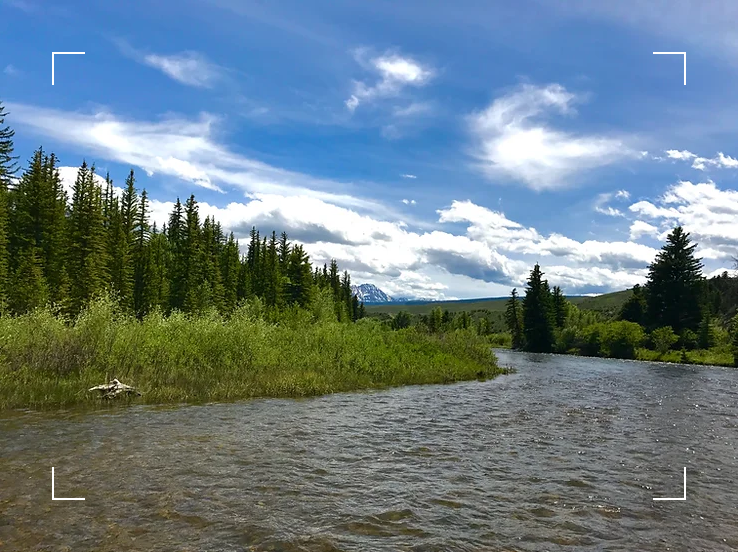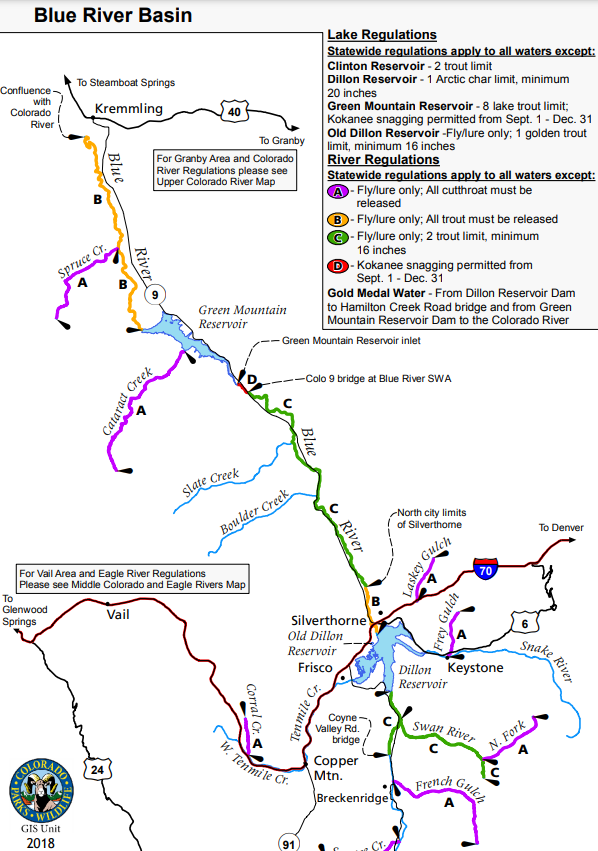Key to Restoring the Middle Blue River to Gold Medal Status might be Phosphorus
How will the middle Blue River return it's Gold Medal status? It starts with an experiment to add a usual pollutant back to the stream.

January 2021
In 2016, Colorado Parks and Wildlife (CPW) removed the Gold Medal designation from the Blue River, north of Silverthorne, Colorado. Though the upper tailwater Blue remained Gold Medal water right below Dillon Reservoir, as anglers traveled downstream they became hard-pressed to find enough sizeable trout to meet the Gold Medal standards. State biologists attribute the delisting to degraded habitat, unnatural stream flows, and a dwindling community of macroinvertebrates (trout food). But now, seven years later, some unconventional ideas have emerged about improving the quality of fishing in this stretch of the Blue River (middle Blue), that once hosted the World Championship of Fly Fishing (2016).
The proving ground won't be the delisted section upstream from Green Mountain Reservoir, but instead below Green Mountain Reservoir, in a mostly private reach. Stakeholders of the Colorado Basin Roundtable voted in support of billionaire Blue Valley Ranch owner Paul T. Jones II's (an infamous character to anglers of the Lower Blue) plan to improve fishing on his property. CPW will be watching closely to see if they can learn anything to apply to the de-listed section of the middle Blue.

What's the plan? The plan is to add phosphorus into the stream, increasing concentrations to promote algal/plant growth and fatten up trout from the bottom of the food web upwards. After Dillon Reservoir was constructed, efforts were taken to keep the reservoir clean. As a result, nutrients and sediment were filtered out before entering the reservoir leaving mostly unpolluted water running downstream. Again impounded further downstream by Green Mountain Reservoir, the water quality throughout the Blue has been low in nutrients. That's not an inherently bad thing, too much nitrogen or phosphorus in streams or lakes can disrupt a balanced stream ecosystem required for trout to thrive. Extreme excess can even lead to harmful algal blooms. Excess can also come from humans, often concentrated through wastewater treatment plant outflow. This is why the state tightly regulates the amount of nutrients (like phosphorus) water users are allowed to discharge into Dillon and along stretches of the Blue near towns. To prevent any blooms in Dillon Reservoir, strict effluent limits exist before water even flows out of the reservoir into the upper tailwater stretch. But have we gotten to the point where we've removed too much phosphorus from the impounded stretches of the Blue River Basin? Is the ecosystem starved for more nutrients? For the trout on Jones private ranch, he thinks so. The same might be true for any remaining trout in the middle stretch.
How is the re-introduction of phosphorus going to help trout exactly?All organisms that produce their own food from sunlight make up the base of the food chain. In streams, that includes plants and phytoplankton. In order for them to produce their own food, they need to metabolize macronutrients, notably nitrogen, and phosphorus. (This is why you find the same elements in fertilizer). However, they are not needed in equal amounts. Plants need about 16 times more nitrogen than phosphorus. Yet there is only so much available across the environment. So if a system has less phosphorus, every molecule of phosphorus gets used, even if there is an excess of available nitrogen. It could also be flipped where nitrogen is more limiting. In fact, in the Western US streams are frequently nitrogen-limited, with a (relative) excess of phosphorus coming from the erosion of igneous (uplifted mountains) and sedimentary (ancient seafloor) rocks. Still, enough phosphorus has settled out of the Blue River drainage via dams and water treatment facilities, that phosphorus is believed to be the key to unlocking increases in Blue river biomass. Once an excess of phosphorus is fed to the plants, macroinvertebrates should have an easier time finding available munchies amongst the bloom. Then it follows that more invertebrates will thrive, and ultimately feed trout. Given a long enough period of application, fat and happy trout will have better reproductive success and slowly trout densities will increase naturally, since more food can support more fish. Of course, the process can be supplemented with fish stocking. But things probably won't go exactly according to this plan. If the phosphorus pulse isn't consistent or doesn't occur long enough, the large pulse could end in a trophic cascade and a trout population crash. Here's how: Lots of available plants leads to lots of available bugs, but without continued inputs of phosphorus to promote plant growth they slowly die, the overabundance of bugs that once had ample food, now overgraze on the dwindling plants and phytoplankton, and eventually trout will find less and less available food.
The point is that no matter the amount of phosphorus applied, it will take time for the dynamics of the stream to equilibrate as the chain of cause and effect ripples through the food web up to the trout. How patient is Jones if he doesn't see results right away?
How are they going to add the phosphorus to the stream?By dropping barrels of liquid fertilizer in the river, the concentration can be calculated to control how much is added to the system. (In most watersheds, the application of fertilizer causes more ecological harm than good). The key will be to add enough to get the trout fat, but not so much to throw the ecosystem out of balance. It is possible though. On Calgary's Bow River, trout grow exceptionally large below the two municipal wastewater treatment plants; the result of warm phosphorus-rich effluent leaving the plants.
Is this a bad idea?Well, there are lots of variables at play that could make it hard to pinpoint what's working and what's not working. Further, what happens downstream from the experimental stretch? That phosphorus might make its way into the Colorado River downstream with unknown consequences. Nonetheless, the Blue River Watershed Group supports this project and has even proposed similar ideas in the past. Plus there might be potential to influence how tailwater fisheries are managed across the West in the future, with many trout fisheries downstream of large reservoirs.
DWAs Final Word
Even if barrels of fertilizer are correctly implemented to boost phosphorus levels without exceedance, the fix is likely a band-aid. Without a natural flow regime and an undisturbed pulse of sediment and nutrients during spring runoff, fertilizer will need to be continuously resupplied. We see this solution as effectively the same thing as trout stocking with a pack lunch. If the phosphorus goes away, the high densities of bugs and trout go away, just as if stocking stopped. Plus, even though Jones has a philanthropic and conservation track record, this still feels like a strategy to improve the fishing on his property. The only way the middle Blue benefits is if CPW were to act on the findings on their own. However, this is the important first step toward renewing the Gold Medal status of the middle Blue. At least the billionaires are paying for and supplying the testing ground on this one. We will be watching to see if it works. Only time will tell.
Sources:
- Denver Post. 2016. Colorado wildlife officials remove ‘Gold Medal’ status of Blue River stretch. https://www.denverpost.com/2016/03/24/colorado-wildlife-officials-remove-gold-medal-status-of-blue-river-stretch/
- Aspen Times. 2020. Tinkering with a pollutant, Colorado ranch seeks to improve fish habitat. https://www.aspentimes.com/news/tinkering-with-a-pollutant-colorado-ranch-seeks-to-improve-fish-habitat/
- Tactical Fly Fisher. 2016. World Championships Vail. CO 2016: Session 5 Blue River. https://www.tacticalflyfisher.com/blog/world-championships-vail-co-2016-session-5-blue-river/
- Water on the Web. 2020. Nutrient Dynamics. https://www.waterontheweb.org/under/streamecology/14_nutrientdynamics-draft.html
- NY Times. 2009. Calgary, a City Where Trout Fishing Does Not Go to Die. https://www.nytimes.com/2009/09/19/sports/19outdoors.html


